Access Ramps

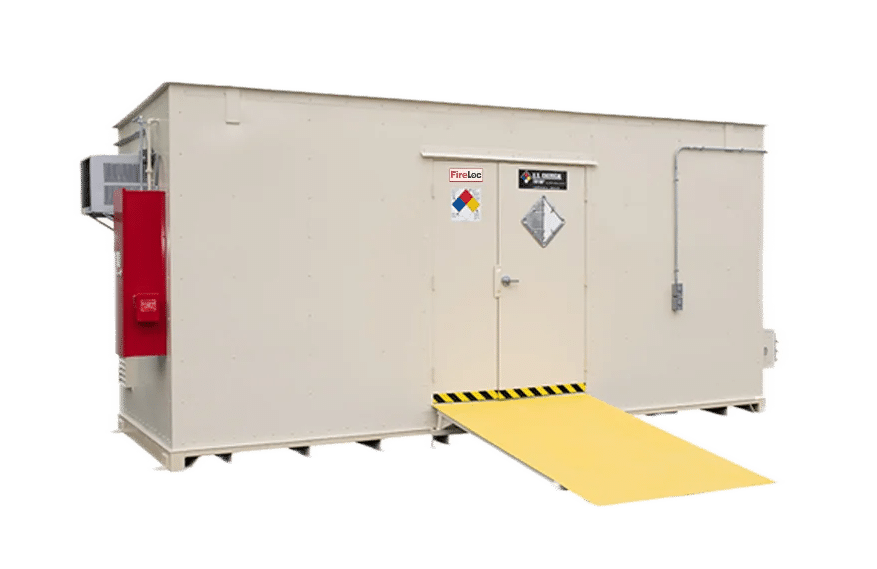
Storage building with ramp
2-Hour Flammable Liquid Storage
Protect your contents from harmful conditions and theft with a storage solution that can meet compliance and codes. Completely customizable FireLoc™ flammable liquid storage buildings are manufactured with bi-directional wall construction. You can modify your FireLoc™ chemical storage building to include explosion prevention systems or explosion relief construction to allow for the storage, mixing, dispensing, and pouring of Class 1A, 1B and 1C flammables.
Trust FireLoc™ buildings to provide a safe chemical storage environment for your business and employees that will last for years to come. All 2-hour fire-rated chemical storage buildings feature fire-resistant gypsum board walls encased between interior and exterior high-quality steel.
Optimize your chemical storage capabilities with a variety of optional explosion proof and fire rated safety accessories. This includes lighting, mechanical ventilation, gas detection, spill detection, climate control and more. Dry chemical fire suppression and water sprinkler assemblies are available for each model. Many configurations and types of storage buildings are available, including modular construction for larger sizes. All 2-hour fire-rated flammable liquid storage buildings can be fabricated to meet EPA and NFPA requirements and can be manufactured with FM approval. *Always consult your local authority with jurisdiction to ensure that all rules and regulations are followed, including proper setback requirements for buildings.
Cutting Edge Wall Design
FireLoc™ flammable liquid storage buildings boast a tested and approved bi-directional design that has passed the fire test for 2-hours, 23-minutes, comes standard with R12 insulation in the cavity, and is rated to a wind load of at least 120 m.p.h. per ASCE-7-10.
Features & Benefits
- Weather-resistant steel construction
- Chemical & UV resistant coating
- Can be manufactured to meet EPA, NFPA 30 and NFPA 1
- Continuously welded, leak-tested sump
- Walk-in or rack style available
- 15-year structural warranty
Common Applications
- Hazardous Waste Storage
- Flammable and Combustible Storage
- Paint and solvent Storage
Downloadable Information & Fact Sheets
- Drawing: 2-Hour Bi-Direction Fire Rated Building (FL6115)
- Design Your Explosive Storage Magazine
- Warranty on Building & Accessories
- Buy or Build Chemical Storage Brochure
- Infographic: Choosing a Chemical Storage Building
- FireLoc 1-page Sheet
Compliance & Approvals
At U.S. Chemical Storage we strive to give you the best solution for your operations. This building and its accompanying accessories can be engineered to meet the following approvals and certifications based upon your unique set of needs.
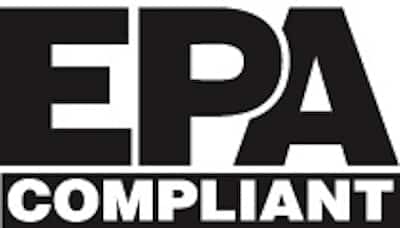
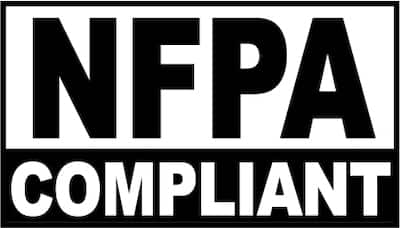


Frequently Asked Questions
First consult the Safety Data Sheet (SDS) to determine the type of chemical you’re storing and any storage requirements listed. There are two main classifications of buildings to consider: fire-rated and non-fire-rated steel buildings.
There are three main questions you should answer before engineering or design can begin on your building: what is to be stored, how much of it is being stored, and where is the location it will be stored? You will also need to consult with your local “Authority Having Jurisdiction” (AHJ) or local code expert to determine your area’s specific storage building requirements.
Our team at U.S. Chemical Storage has a wealth of knowledge, experience, and resources to help analyze your storage needs, but the final approval is made by the local AHJ, so you will need to ultimately ask them about your requirements early in the planning process.
The definition of a “sump” is a pit or reservoir providing containment for spilled liquids. U.S. Chemical Storage offers leak-proof spill containment sumps in each standard model. All our sumps are tested for leaks for a 24-hour period prior to finishing. The sump is then covered by a steel or fiberglass floor grating and can even be equipped with a resistant plastic sump liner to protect against corrosive chemical accidental spills. The size of the sump is dictated by code based on the volume of liquid being stored within the building.
Building size is determined by the amount of hazardous material you are planning to store, the need for occupancy or inspection around these materials, and must take into consideration the most efficient way of moving these materials into and out of your chemical storage building.
Location of the building can be either inside another building or outside to fit your needs. Fire Separation, which is the amount of fire rating required between two occupancies, or the separation distance between those two occupancies, is determined by the type of chemical or hazard being stored, and distances between buildings, egress pathways, or environmental features. To determine the required fire separation, it is best to consult with your local code authority. Inside another building or within 10 feet of another building, you’ll be required to have a 4-hour fire rating. If your hazmat storage building is located at distances 30 feet or greater your building may not be required to have a fire rating at all.

Request a Quote
RELATED PRODUCTS
Explosion Relief Panels
Explosion relief panels are available for the compliant storage or mixing and dispensing of Class 1A and 1B flammables.
Chemical Storage Building Doors
Doors are the first line of defense when protecting your chemical assets and preventing accidents; we offer a variety of door systems.
RELATED ARTICLES
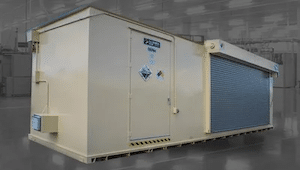
How To Store Lithium Batteries
Lithium batteries are often used in today’s electronic environments.
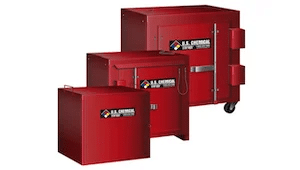
Explosive Storage Magazines
Prevent accidents by storing your high and low explosives properly.

Pharma Hazmat Storage
This manufacturing process needed a compliant 90 day storage solution.



